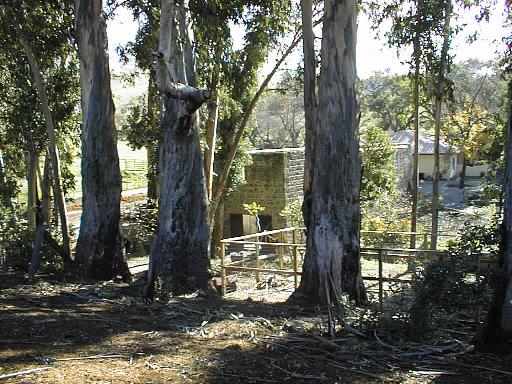Up: Mission Peak main page Next: McClure Ranch on Mission Peak Previous Hikes Starting from Stanford Avenue
![]()
![]()
![]()
Up: Mission Peak
main page Next: McClure Ranch on
Mission Peak Previous Hikes Starting from Stanford
Avenue
by Dennis Rockstroh, SJ Mercury News Staff Writer
Published: Sunday March 14, 1999

Photo by Wolfgang S. Rupprecht
You might have to close your eyes to see the rich past of Hidden Valley on a Warms Springs hillside below Mission Peak.
Over the centuries, the Ohlone, Spanish, Mexicans, Californios, Americans and others played and relaxed in the warm resort waters of Agua Caliente (warm springs) Creek in Fremont.
Today posh new homes have replaced the exclusive hotel and spa resort of the late 19th century.
At the heart of this modern upper-crust village is a lone, old winery building that can't begin to measure the importance of the site along Stanford Avenue. It is destined to become a small community center.
Just about everything else from previous eras is gone except for the walls of a stone winery building on private property.
Stand at the corner of Stanford and Vineyard avenues and you can hear the babble of the creek that played such an important part in Warm Springs' past.
In your mind's eye, you can see the people who used its once-warm waters to bathe, wash their clothes or heal their weary bodies. They were the American Indians of ancient times, the Mexican and Spanish of the era of exploration, and the American settlers.
The last major building there was the A.A. Cohen Hotel, which burned down in 1992.
The three-story, white-with-red-trim hotel -- the only surviving building from a 19th-century spa -- was part of the first hot springs resort on the West Coast. When it opened in the early 1850s, it catered to the elite of the new state of California.
When Clement Columbet opened the spa, there were 10 buildings on both sides of Agua Caliente Creek. Springs fed warm soda-, borax- and sulfur-enhanced water into the basement of six buildings.
In its heyday, the spa attracted the likes of Pio Pico, the last Mexican governor of California; Sen. George Hearst of the newspaper empire; Domingo Ghiradelli of the chocolate family; and Adolph Sutro, mayor of San Francisco and owner of a competing bath at the Cliff House.
The spa's life was cut short in 1868 when a 7.5-magnitude earthquake shattered the East Bay along the Hayward Fault.
Later owned by the Stanford family, the ranch was once considered a possible site for Stanford University. Now the only place to get a higher education there is to climb Mission Peak above.
In recent years, Hidden Valley ranch was rented out for company and group picnics, and the hotel housed a bar and Mexican restaurant.
It is best known as the onetime home of Leland Stanford, who entered the Warm Springs scene in 1869.
The New York native and Wisconsin lawyer came to California in 1852 and joined his two brothers in running a chain of hardware stores supplying gold miners.
Later Stanford and three Sacramento merchants -- Collis P. Huntington, Charles Crocker and Mark Hopkins -- agreed to underwrite the western link of the transcontinental railroad.
Stanford was chosen president of Central Pacific, later known as the Southern Pacific Railroad. He was elected governor on the pro-Lincoln ticket in 1861 and after a two year term resumed his duties as railroad president.
Seven years later, Stanford bought the Warm Springs property, about 4,000 acres that ran from today's Mission Boulevard to the top of Mission Peak.
As the stories go, Warm Springs could have been the site of Stanford University, except that his wife, Jane, preferred living on the Peninsula.
And so they left.
The Stanfords were living on their Palo Alto farm when, in 1884, their 15-year-old son, Leland Jr., died.
They established Stanford University in their son's memory.
The Stanford home in Warm Springs was demolished sometime in the last decade. The rock-and-brass monument and the little brick winery building is the last vestige of the Stanfords' presence on this side of the bay.
The elder Stanford died in 1893 in Palo Alto at the age of 69, and he probably died happy. His last meal, a few hours earlier, included nine lamb chops.